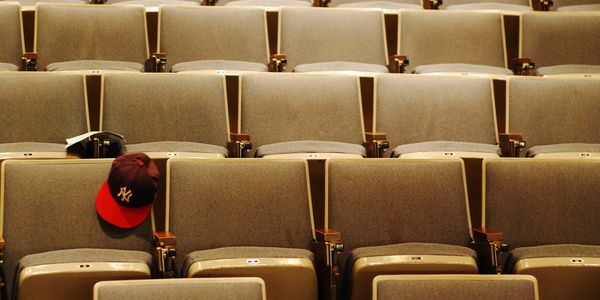Grantmakers Think It's Cool. So Do Universities. The Students? Not So Much
/
We've written a bunch lately about how foundations are modernizing the humanities for the digital age.
In the process, we've seen lots of innovative approaches in terms of training teachers, refreshing curricula, and adopting cutting-edge technologies. But sometimes an important question—no, the most important question—gets lost in the mix: what do the students think?
After all, at the end of the day, the students—not professors or administrators or consultants or foundations—are the consumers, or "end users" in philanthro-speak. Their buy-in reflects the efficacy of the strategy or program.
One funder that seems to understand this is the Teagle Foundation. Along with the Andrew W. Mellon Foundation, it's played a huge role in defining liberal arts' role the modern workforce.
The foundation recently brought together grant recipients to provide updates involving various blended learning efforts in the liberal arts arena. Blended learning combines face-to-face instruction with online activities. These collaborative projects looped in over 110 faculty members and 115 students from about 40 colleges and universities and 16 states. By understanding what, precisely, liberal arts students think of this approach, nonprofit education outlets and schools can develop more engaging curricula that can potentially attract greater foundation interest.
So let's get right down to it. What works? And what doesn't work? To get to these answers, grant recipients were asked to consider which learning strategies and technologies "lower costs, improve access to and the quality of education, and fit liberal arts curricula."
Turns out the one technology that can lower costs and improve access doesn't exactly resonate with liberal arts students. To understand what we mean, we must first establish the line of conventional wisdom that the panel inadvertently invalidated.
The thinking goes like this: Twenty-year olds love technology. The more a curriculum embraces cutting-edge technology, the better. Kids grew up online; they'll wholeheartedly embrace online learning. If anything, it's the professor, we're led to believe, who needs to be dragged, kicking and screaming, into the digital classroom.
And yet when six member institutions of the Council of Public Liberal Arts Colleges cited low online course enrollments stemming from "student resistance," many were surprised to find that the root cause of this resistance was the fact that liberal arts students simply don't like online classes.
"Enrollment has been a bit more uneven than we expected," the council reported, "even factoring in our audience, given that we have such high demand on our campuses for greater variety in the indigenous studies curricula on our campuses."
In other words, the findings suggest that online-centric funding priorities may be out of step with the desires of your typical liberal arts student. Addressing the assembled schools, Loni Bordoloi, one of the Teagle Foundation's program directors, was direct: "Your students chose your institutions for a reason. They wanted, by and large, a residential liberal arts experience." (Emphasis added.)
Does anyone else see the irony here?
For years, we've heard that the liberal arts education experience should be a collaborative one, conducted in-person, with a teacher in the room and students engaged in lively debate and perhaps even standing on tables, reciting Walt Whitman. (Think Dead Poet's Society.) The idea of a liberal arts student sitting in their dorm room glued to a computer screen is blasphemy.
Despite the handwringing from more traditionalist quarters, universities and grantmakers proceeded full-speed ahead with their digital investments, bewitched by the power of technology—and, in their defense, the affordability and improved access it provides. And yet at the end of the day, we find that it's the students themselves indirectly telling the grown ups, "Sorry, but this isn't what liberal arts education is about."
All of which raises the next question: How did it get to this point? The culprit, according to Teagle Foundation President Judith R. Shapiro, is the siren song of "innovation fetishism." It's the idea that administrators and grantmakers fall under the spell of shiny new technological goodies that ultimately detract from fundamentally more meaningful—albeit far less sexy—liberal arts teaching methods.
It also underscores the risks of pigeonholing liberal arts students. When it comes to online and blended learning at the university level, one size doesn't fit all. Just because an engineering or physics major enjoys the solitude of online courses, it doesn't mean liberal arts students will, particularly when their area of study relies on robust debate, critical dialogue, and the occasional standing on tables. There are distinctly different psychographic profiles at play here.
That said, Teagle's participants don't advocate throwing the blending learning baby out with the bathwater. (Weird, right?) After all, online courses are an affordable and convenient option for students of all stripes, liberal arts or otherwise. Instead, participants articulated strategies that incrementally phase in aspects of blended learning into liberal arts curricula, rather than embrace an aggressive, across-the-board push that leaves students demoralized:
Potential solutions included starting hybrid courses off with low-stakes assignments, letting students evaluate the course halfway through the semester and recruiting former students to serve as hybrid learning ambassadors.
It kind of reminds us of Bernie Sanders' campaign. He's calling for a "political revolution." That sounds nice in theory, but revolutions are messy and bloody. Teagle's takeaways suggest that not all components of our lives need to be disrupted or dramatically "revolutionized"—especially the liberal arts.








